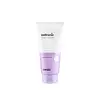What's inside
What's inside
 Key Ingredients
Key Ingredients

 Benefits
Benefits

 Concerns
Concerns

 Ingredients Side-by-side
Ingredients Side-by-side

Water
Skin ConditioningMyristic Acid
CleansingGlycerin
HumectantPalmitic Acid
EmollientSorbitol
HumectantPotassium Hydroxide
BufferingStearic Acid
CleansingLauric Acid
CleansingCeramide AP
Skin Conditioning1,2-Hexanediol
Skin ConditioningHouttuynia Cordata Extract
Skin ConditioningSorbitan Olivate
EmulsifyingEthylhexylglycerin
Skin ConditioningArachidic Acid
CleansingAcrylates/C10-30 Alkyl Acrylate Crosspolymer
Emulsion StabilisingDisodium EDTA
Butylene Glycol
HumectantPentylene Glycol
Skin ConditioningSqualene
EmollientVitis Vinifera Fruit Extract
Skin ConditioningCitric Acid
BufferingDiospyros Kaki Leaf Extract
Skin ProtectingGluconolactone
Skin ConditioningCoffea Arabica Seed Extract
MaskingCarthamus Tinctorius Flower Extract
Skin ConditioningPolygonum Cuspidatum Root Extract
AntioxidantZanthoxylum Piperitum Fruit Extract
Skin ConditioningCastanea Crenata Shell Extract
Skin ConditioningCamellia Sinensis Leaf Extract
AntimicrobialHydrolyzed Hyaluronic Acid
HumectantAnthemis Nobilis Flower Extract
MaskingSodium Hyaluronate Crosspolymer
HumectantSodium Hyaluronate
HumectantHydrolyzed Sodium Hyaluronate
Skin ConditioningHyaluronic Acid
HumectantWater, Myristic Acid, Glycerin, Palmitic Acid, Sorbitol, Potassium Hydroxide, Stearic Acid, Lauric Acid, Ceramide AP, 1,2-Hexanediol, Houttuynia Cordata Extract, Sorbitan Olivate, Ethylhexylglycerin, Arachidic Acid, Acrylates/C10-30 Alkyl Acrylate Crosspolymer, Disodium EDTA, Butylene Glycol, Pentylene Glycol, Squalene, Vitis Vinifera Fruit Extract, Citric Acid, Diospyros Kaki Leaf Extract, Gluconolactone, Coffea Arabica Seed Extract, Carthamus Tinctorius Flower Extract, Polygonum Cuspidatum Root Extract, Zanthoxylum Piperitum Fruit Extract, Castanea Crenata Shell Extract, Camellia Sinensis Leaf Extract, Hydrolyzed Hyaluronic Acid, Anthemis Nobilis Flower Extract, Sodium Hyaluronate Crosspolymer, Sodium Hyaluronate, Hydrolyzed Sodium Hyaluronate, Hyaluronic Acid
Water
Skin ConditioningAcrylates Copolymer
Coco-Betaine
CleansingGlycerin
HumectantArginine
Masking1,2-Hexanediol
Skin ConditioningCucumis Sativus Fruit Extract
EmollientMyrciaria Dubia Fruit Extract
Skin ConditioningEuterpe Oleracea Fruit Extract
Persea Gratissima Fruit Extract
EmollientSpirulina Platensis Extract
Skin ProtectingCentella Asiatica Extract
CleansingMelaleuca Alternifolia Leaf Extract
PerfumingCamellia Sinensis Leaf Extract
AntimicrobialAllantoin
Skin ConditioningOryza Sativa Bran Extract
Skin ConditioningCarica Papaya Fruit Extract
Skin ConditioningDisodium EDTA
Squalane
EmollientLavandula Angustifolia Oil
MaskingWater, Acrylates Copolymer, Coco-Betaine, Glycerin, Arginine, 1,2-Hexanediol, Cucumis Sativus Fruit Extract, Myrciaria Dubia Fruit Extract, Euterpe Oleracea Fruit Extract, Persea Gratissima Fruit Extract, Spirulina Platensis Extract, Centella Asiatica Extract, Melaleuca Alternifolia Leaf Extract, Camellia Sinensis Leaf Extract, Allantoin, Oryza Sativa Bran Extract, Carica Papaya Fruit Extract, Disodium EDTA, Squalane, Lavandula Angustifolia Oil
Ingredients Explained
These ingredients are found in both products.
Ingredients higher up in an ingredient list are typically present in a larger amount.
1,2-Hexanediol is a synthetic liquid and another multi-functional powerhouse.
It is a:
- Humectant, drawing moisture into the skin
- Emollient, helping to soften skin
- Solvent, dispersing and stabilizing formulas
- Preservative booster, enhancing the antimicrobial activity of other preservatives
Camellia Sinensis Leaf Extract is derived from the leaves of the tea plant. Black tea, green tea, and oolong tea are all harvested from this plant.
This ingredient has many skin benefits:
This ingredient contains polyphenols, a strong antioxidant. Antioxidants help fight off molecules that damage skin cells.
On top of that, the antioxidants in green tea neutralize free-radicals from the sun. This gives the skin some extra UV protection, but should not replace sunscreen.
Many components of tea have anti-inflammatory properties.
Polyphenols and L-theanine help soothe the skin and reduce irritation. The caffeine in Camellia Sinensis Leaf Extract helps calm inflamed blood vessels.
Other compounds found in tea include: Vitamin Bs, linoleic acid, magnesium, calcium, iron, and zinc.
Research has shown both drinking Camellia Sinensis Leaf Tea and applying it to the skin can help boost skin elasticity and hydration. Studies also show using tea extract may reduce sebum, or oil, production.
Learn more about Camellia Sinensis Leaf ExtractDisodium EDTA plays a role in making products more stable by aiding other preservatives.
It is a chelating agent, meaning it neutralizes metal ions that may be found in a product.
Disodium EDTA is a salt of edetic acid and is found to be safe in cosmetic ingredients.
Learn more about Disodium EDTAGlycerin is already naturally found in your skin. It helps moisturize and protect your skin.
A study from 2016 found glycerin to be more effective as a humectant than AHAs and hyaluronic acid.
As a humectant, it helps the skin stay hydrated by pulling moisture to your skin. The low molecular weight of glycerin allows it to pull moisture into the deeper layers of your skin.
Hydrated skin improves your skin barrier; Your skin barrier helps protect against irritants and bacteria.
Glycerin has also been found to have antimicrobial and antiviral properties. Due to these properties, glycerin is often used in wound and burn treatments.
In cosmetics, glycerin is usually derived from plants such as soybean or palm. However, it can also be sourced from animals, such as tallow or animal fat.
This ingredient is organic, colorless, odorless, and non-toxic.
Glycerin is the name for this ingredient in American English. British English uses Glycerol/Glycerine.
Learn more about GlycerinWater. It's the most common cosmetic ingredient of all. You'll usually see it at the top of ingredient lists, meaning that it makes up the largest part of the product.
So why is it so popular? Water most often acts as a solvent - this means that it helps dissolve other ingredients into the formulation.
You'll also recognize water as that liquid we all need to stay alive. If you see this, drink a glass of water. Stay hydrated!
Learn more about Water